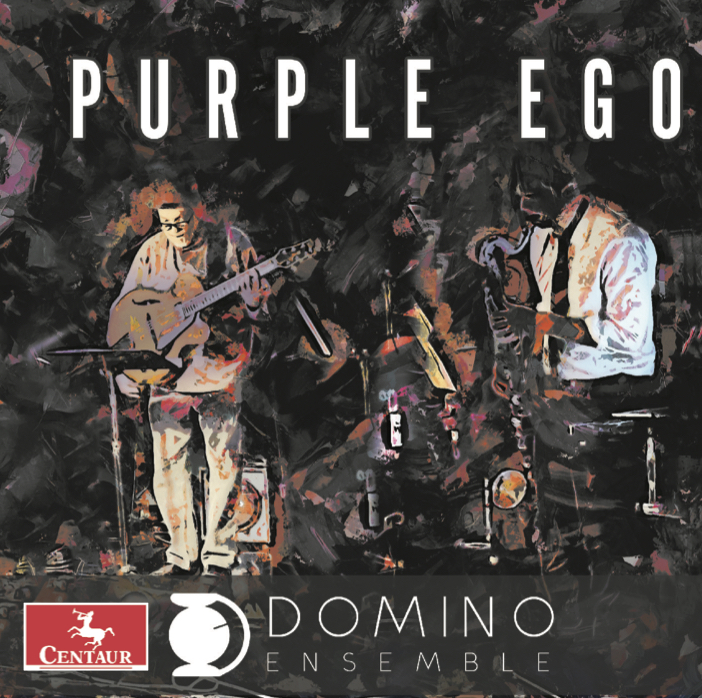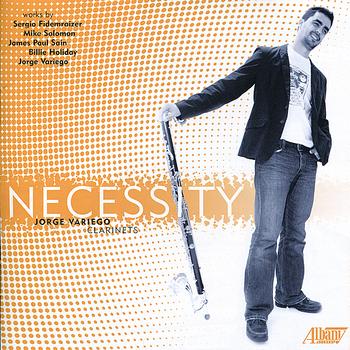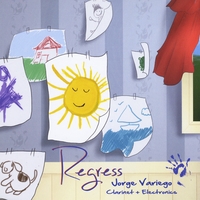Jorge Variego is young clarinetist and composer from Argentina, working his way through American academia as a PhD candidate at the University of Florida. It’s a bold move for someone with a relatively slight resumé to release a disc on a major label. The music is of varying interest, but the playing is engaging and expressive, and he has clearly marked himself as an artist to watch.
Variego himself is the composer for more than half the music on the disc, and much of it shows a keen imagination and impressive technical skill. Three of the movements are part of his Clarinet Quartet No. 1, but they appear separately rather than in sequence. The four voices are played by the clarinetist in pre-recorded layers, though the notes don’t explicitly make this clear. The first movement (Statement) gives most of the leading material to the bass clarinet, while the other voices provide nicely textured accompaniment, some of it sounding deliberately unaligned and perhaps partly improvised. Deceptive Palindrome is the title given to the second movement, a curious and persuasive experiment that alters traditional notions of cadence. The last movement is called Final Statement, and is perhaps my favorite track on the disc. It may seem to some as derivative of Xenakis, but there are certainly worse models for a young composer. It is based in part on homophonic blocks of sound that move in clusters. Song is a relatively simple and mournful duet, filled with expressive lyricism. The vivid, colorful Giant Shapes throws computer-generated sounds into the mix.
Sergio Fidemraiser’s Viento Sur was composed for one of the gods of the bass clarinet, Harry Sparnaay. It includes a rather dense track of prerecorded sounds, with plenty of key clicks and airy sounds that conjure the wind. The foreground and background positions of the recorded sounds are well-mastered and evocative.
It’s almost a cliché these days for a bass clarinetist to take on Eric Dolphy’s version of Billie Holiday’s “God Bless the Child”, but Variego’s version is nimble, soulful, and full of character. Mike Solomon’s Una passeggiata per la Piazza San Marco is a gripping, dizzying thrill ride, and James Paul Sain’s Kornighet boasts sophisticated, state-of-the-art sound manipulation.
Overall, this is an impressive, audacious debut, and I have no doubt that even better things lie ahead for this young talent. Michael Cameron
Listen to some CD excerpts here:
Giant shapes (clarinet and computer)
___________________________________________________________________________________
Regress – CD review
They say you can’t tell a book by its cover. That’s certainly true of this release, which sports a colorful illustration of childlike drawings pinned to a wall, suggesting that the music contained within would be suitable for a toddler’s naptime or a birthday party sing-along, when in fact the program consists of highly sophisticated and challenging electroacoustic works by Argentinean composers ranging in age from 72 to 30-something. The album title too, I suppose, is meant to be taken with the same ironic grain of salt, since the music is hardly indicative of a regressive approach to composition—although the concept does come out of a tradition of instrument-plus-tape or -electronics that includes another, pioneering Argentinean composer, Mario Davidovsky. (No reference to Davidovsky, or any other precedent, or for that matter any biographical information about the composers, is to be found in the exceptionally sparse annotation.) This is clarinetist Variego’s second solo disc; the first, Necessity (Albany), was called “an impressive, audacious debut” by Michael Cameron in Fanfare 34:1, while in the same issue Raymond Tuttle admitted it was “terrifically interesting” but primarily to “clarinet nerds” and other “unusual” listeners.
Nearly all of the works here result from the combination of “live” clarinet or bass clarinet, computer processing to manipulate or multiply the clarinet sound in real time, and what is described as “fixed media”—a previously composed and recorded tape or electronic component. Moreover, there are other similarities, in that each creates what could be described as a dramatic sound environment rather than a conventional compositional structure, therefore more spontaneous and unpredictable, and offering a breadth of surprising colors and textures. But there are distinctive qualities as well. Claudio Lluán’s Música Nocturna (2010) offers the most lyrical, albeit circuitous, clarinet contribution, even as the solo instrument is shadowed by processed echo effects. Daniel Schachter’s Una Caña (2012) features indeterminate modular, interactive scored elements, a dense forest of processed clarinets, and a playful, mechanistic ambience. Imaginarios 2012 (2010) by Dante Grela Herrera (here credited simply as Dante Grela H.) provides a polyphonic fabric, with a congestion of attacks from different spatial directions, extended clarinet techniques, and hollow, metallic electronic timbres. Martin Gendelman’s Reflejos (2012) contrasts florid bass clarinet lines with impassive programmed electronic responses, while No Clarinet Input (2012) by Santiago Diez Fischer inhabits a subterranean world of microscopic details, asking the listener to “abandon the belief of familiar sounds.” Finally, the jazz implications of Variego’s own piece, Ornet (2012) –computer-generated piano and percussion accompanying the bass clarinet’s breath-and-reed-distorted tone and out-of-synch lines—reveal no audible relation to the punning reference (to jazz innovator Ornette Coleman) of the title.
Valley City State University and the North Dakota Council of the Arts, both of which partially funded this recording, deserve kudos for their support of such fascinating, adventurous music. And I agree with Michael Cameron, Variego is an artist to watch. Art Lange
___________________________________________________________________________________

Purple ego – CD review
Domino Ensemble impresses with an astonishing new release. The album has a strong focus on unique tones and forward-thinking arrangements, elevating modern jazz music to a status of pure art form.
The sound of this release has really beautiful production, which brings class and smoothness to each cut. The instrumentals are highly dynamic and touching, and in particular, the amazing twist of the lead clarinet really brings a sense of identity to each track. It’s a true joy to hear this amazing ensemble of world-class musicians interact with one another, feeding off of each other’s chemistry and ability to create massively infectious, yet classy and understated melodies.
Whether you are a fan of modern jazz, or you prefer the old guard, you’ll certainly be impressed by Domino Ensemble. This group has got so much to offer, and they bring an unprecedented level of charisma to this genre today. – Jazz Corner September 2019.
___________________________________________________________________________________
Selection of videos of live performances
For more videos, please visit my Youtube channel here.

